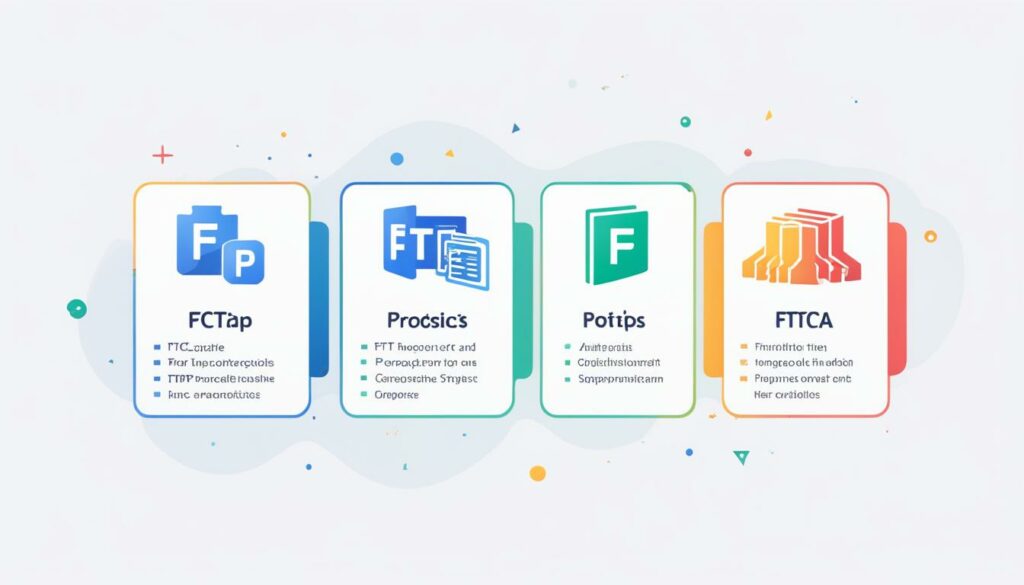Welcome to our guide on FTP, or File Transfer Protocol. Whether you’re a business owner, a website administrator, or someone who needs to transfer files between computers, understanding FTP is essential. In this article, we’ll break down everything you need to know about FTP, from its basic principles to its importance and uses.
FTP is a network protocol that enables the secure and efficient transfer of files between computers over TCP/IP connections. It operates on a client-server model, with the client initiating a connection with the server to transfer files. This protocol uses two communication channels, a command channel for controlling the conversation and a data channel for transmitting file content.
FTP can be used for various purposes, including backup, replication, and access to shared hosting and cloud services. It provides a reliable and efficient method for transferring files, making it an indispensable tool for businesses and individuals alike.
Key Takeaways:
- FTP is a network protocol for secure and efficient file transfers over TCP/IP connections.
- It operates on a client-server model, with a command channel for controlling the conversation and a data channel for transferring file content.
- FTP is used for various purposes, including backup, replication, and accessing shared hosting and cloud services.
- There are different types of FTP, including anonymous FTP, password-protected FTP, FTPS, FTPES, and SFTP.
- FTP clients, such as FileZilla, Transmit, WinSCP, and WS_FTP, are software applications used to manage file transfers on an FTP server.
Now that you have a basic understanding of FTP, let’s dive deeper into how it works and why it is important in the next sections.
How does FTP work?
FTP, or File Transfer Protocol, functions through a client-server model and uses TCP/IP connections to facilitate file transfers. Understanding how FTP works is crucial for effective and efficient file management. Let’s delve into the mechanics of this protocol.
When initiating an FTP transfer, the client establishes a connection with the server. This connection is established over TCP/IP, ensuring reliable and secure communication between the client and server.
FTP operates using two distinct channels: the command channel and the data channel. The client sends commands to the server through the command channel. These commands instruct the server to perform specific actions, such as listing directories or transferring files.
Once the server receives the commands, it responds accordingly and proceeds to establish a data channel. The data channel is responsible for transmitting the actual file content. This two-channel system allows for efficient and streamlined file transfers.
FTP can operate in two modes: active mode and passive mode. In active mode, the server initiates a connection back to the client for data transmission. Passive mode, on the other hand, allows the client to establish the data connection.
In active mode, the client specifies which IP address and port the server should use for the data connection. The server then initiates the connection to the specified IP address and port. This mode can be challenging in certain network setups due to firewall limitations.
Passive mode, on the other hand, is more suitable for most network configurations. In passive mode, the server provides the client with an IP address and port for the data connection. The client initiates the data connection to the specified IP address and port.
To summarize, FTP works by establishing a connection between a client and a server through TCP/IP connections. The client sends commands through the command channel, and the server responds and establishes a data channel to transmit the file content. This two-channel system, along with active and passive modes, ensures efficient and secure file transfers.
FTP Connection Overview:
| Channel | Description |
|---|---|
| Command Channel | Responsible for sending commands from the client to the server and receiving responses. |
| Data Channel | Transmits the actual file content between the client and the server. |
Understanding how FTP works is crucial for efficient file transfers. By establishing a connection, sending commands, and utilizing the command and data channels, FTP provides a reliable and secure method for transferring files between systems.
Why is FTP important and what is it used for?
FTP (File Transfer Protocol) is an essential network protocol that enables the transfer of files across IP networks. It provides a reliable and efficient method for transferring files between systems, making it a foundational tool for file management.
“FTP allows you to transfer files seamlessly between your computer and remote servers, enabling easy collaboration and data sharing.”
One of the primary uses of FTP is for backup purposes. With FTP, you can back up your important data to a remote server, ensuring its safety and accessibility in case of any local system failures. This backup capability provides peace of mind and protects against data loss.
FTP is also widely used for replication, which involves duplicating data from one system to another. This replication process helps ensure that critical files are available on multiple systems, increasing availability and creating redundancy for improved resilience.
Additionally, FTP allows access to shared hosting and cloud services. With FTP, you can load your data onto a remote system, whether it’s a shared web hosting platform or cloud service. This capability simplifies the management and transfer of files, making it easier to collaborate with others and leverage cloud storage solutions efficiently.
Benefits of Using FTP:
- Ease of file transfer across IP networks
- Reliable and efficient method for transferring files
- Ensures data backup and protection against local failures
- Enables replication for higher availability and resilience
- Facilitates access to shared hosting and cloud services

By utilizing FTP, you gain the ability to seamlessly transfer files between systems, ensuring data integrity and accessibility. Whether it’s for backup purposes, replication needs, or accessing shared hosting and cloud services, FTP offers a reliable solution for file management.
To optimize your FTP experience, hosting providers like BoostedHost offer specialized WordPress Hosting services designed to enhance performance and facilitate seamless file transfers. Consider signing up for WordPress Hosting with BoostedHost today for a seamless FTP experience. Visit www.boostedhost.com/wordpress-hosting to learn more.
FTP types
When it comes to file transfers, there are several types of FTP that you can utilize. Each type offers different features and security options to cater to various needs. Let’s take a closer look at the different FTP types available:
1. Anonymous FTP
Anonymous FTP allows for the transfer of files without encrypting data or requiring a username and password. It is commonly used for downloading materials that are intended for unrestricted distribution. This type of FTP is often used by public repositories and software archives.
2. Password-protected FTP
Password-protected FTP, as the name suggests, requires users to enter a username and password to access the FTP server. This type of FTP provides an added layer of security, ensuring that only authorized users can access and transfer files. Password-protected FTP is commonly used in businesses and organizations to protect sensitive data.
3. FTP Secure (FTPS)
FTP Secure (FTPS) is a secure version of FTP that provides implicit Transport Layer Security (TLS) as soon as the FTP connection is established. TLS encryption ensures that data transfers are protected from unauthorized access and interceptions, providing enhanced security for file transfers.
4. FTP over explicit SSL/TLS (FTPES)
FTP over explicit SSL/TLS (FTPES) is another secure FTP option that provides explicit TLS support. With FTPES, the FTP connection is upgraded to an encrypted connection, protecting data transfers from eavesdropping and unauthorized access. It is commonly used in situations where explicit security is required.
5. Secure FTP (SFTP)
Secure FTP (SFTP) is a subset of the SSH protocol that provides a secure mechanism for file transfer. SFTP encrypts both commands and data, ensuring that file transfers are protected from interception and unauthorized access. It is commonly used for secure file transfers in enterprise environments.
Understanding the different types of FTP available allows you to choose the most suitable option for your file transfer needs. Whether you require unrestricted file sharing, password-protected access, or enhanced security through encryption, there is an FTP type that can meet your requirements.

FTP Security
FTP has undergone updates and enhancements to improve its security. By default, FTP does not encrypt traffic, allowing attackers to capture usernames, passwords, and other data. However, there are protocols and methods available to ensure secure file transfer and protect sensitive information during the transfer process.
- FTPS: FTP Secure (FTPS) is a protocol that provides encryption to protect data during transfer. It establishes an implicit Transport Layer Security (TLS) connection as soon as the FTP connection is established, ensuring a secure and encrypted communication channel between the client and the server.
- FTPES: FTP over explicit SSL/TLS (FTPES) is another protocol that enables explicit TLS support in FTP connections. It allows the client and server to negotiate a secure connection after the FTP connection is established, ensuring the encryption of data during transfer.
- SFTP: Secure FTP (SFTP) is a different protocol that operates within the SSH (Secure Shell) protocol. It provides a mechanism for secure file transfer, utilizing encryption to protect data during transit. SFTP is often used as a secure alternative to FTP.
These security measures provide additional layers of encryption and authentication to ensure the secure transfer of files. However, it is important to note that even with these security protocols in place, FTP may still have vulnerabilities that can be exploited by attackers.
FTP may be susceptible to brute-force attacks, where attackers attempt to gain unauthorized access by systematically trying different combinations of usernames and passwords. It is essential to use strong, unique passwords and implement mechanisms to prevent or detect these types of attacks.
Another vulnerability in FTP is the FTP bounce attack, where an attacker uses the FTP server to perform port scanning or connect to other systems indirectly. This can be mitigated by configuring firewalls and access controls to limit the FTP server’s functionalities and connections.
Furthermore, FTP may also be targeted by distributed denial-of-service (DDoS) attacks, where multiple systems overwhelm the FTP server with a flood of requests, rendering it unavailable for legitimate users. Implementing network-level protections and monitoring systems can help mitigate the impact of such attacks.

Overall, while FTP has evolved to include security measures such as FTPS, FTPES, and SFTP, it is essential to remain vigilant and take additional steps to protect against potential vulnerabilities. Regularly updating and patching FTP software, implementing strong access controls, and utilizing security best practices are crucial to ensuring a secure and reliable file transfer process.
History of FTP
The File Transfer Protocol (FTP) has a rich history that dates back to 1971. It was first described in a white paper by Abhay Bhushan, paving the way for the secure transfer of data files over the ARPANET, the predecessor to the internet.
FTP has evolved over the years to align with networking standards, including the widely used TCP/IP protocol. One notable milestone in the development of FTP was the introduction of RFC 959 in 1985. This RFC brought new management capabilities to the protocol, enhancing its efficiency and usability.
As technology progressed, FTP continued to adapt. In RFC 2428, FTP was updated to support the growing adoption of the IPv6 protocol. These updates ensure that FTP remains compatible with modern networking infrastructures, enabling seamless file transfers across the internet.

“FTP has a long-standing history and has played a significant role in facilitating efficient file transfers over the internet. Its development and updates, such as RFC 959 and RFC 2428, have allowed FTP to evolve and remain relevant in today’s digital landscape.”
Key Milestones of FTP:
- 1971: Abhay Bhushan describes FTP in a white paper.
- 1985: RFC 959 introduces new management capabilities for FTP.
- 1999: RFC 2428 enables FTP support for the IPv6 protocol.
FTP clients
FTP clients are essential software applications that enable you to effortlessly upload, download, and manage files on an FTP server. These clients provide a user-friendly interface, making file transfers a breeze. Let’s take a look at some popular FTP clients:
- FileZilla: FileZilla is a widely-used, free FTP client available for Windows, macOS, and Linux. It offers a range of features and supports FTPS and SFTP for secure file transfers.
- Transmit: Transmit is a powerful FTP client designed exclusively for macOS. It boasts a sleek interface and offers advanced features like batch and sync transfers, as well as support for FTP, SFTP, and WebDAV protocols.
- WinSCP: WinSCP is a popular FTP client for Windows, offering a combination of ease-of-use and extensive functionality. It supports both SCP and SFTP protocols and provides a dual-pane interface for efficient file management.
- WS_FTP: WS_FTP is a professional-grade FTP client used by businesses and organizations worldwide. It offers robust security features, including data encryption, secure file transfer protocols, and advanced automation capabilities.
If you’re looking for a reliable and user-friendly FTP client, consider trying one of these options. They provide seamless file transfer experiences and ensure the security of your data.
In addition to these FTP clients, there are many other options available in the market. It’s important to choose an FTP client that best suits your specific needs and preferences.
What to Look for in an FTP Client
When choosing an FTP client, there are several features that you should consider. These features can greatly enhance your file transfer experience and provide added convenience and security. Here are some key features to look for:
Bandwidth Limits
Some FTP clients allow you to set bandwidth limits for files. This feature gives you control over your upload and download speeds, allowing you to prioritize certain transfers and optimize your network usage.
Public-Key Authentication
Enhancing security during file transfers is crucial, especially when dealing with sensitive information. Look for FTP clients that offer public-key authentication. This feature ensures that only authorized parties can access and transfer files, adding an extra layer of protection to your data.
File Compression
File compression can be a handy feature, as it helps reduce the size of your files and allows you to transfer them more quickly. Some FTP clients offer built-in file compression tools, making it easier and more efficient to transfer large files.
File Search
When working with a large number of files on an FTP server, finding specific files can become time-consuming. Look for FTP clients that provide file search capabilities. These tools allow you to search for files based on specific criteria or file masks, saving you time and effort.
Remember to consider your specific needs and preferences when choosing an FTP client. Each client may offer different features and capabilities, so it’s essential to find one that aligns with your requirements. With the right FTP client, you can enjoy seamless and secure file transfers.
| Feature | Description |
|---|---|
| Bandwidth Limits | Allows you to set upload and download speed limits for files. |
| Public-Key Authentication | Enhances security by requiring authorized access through public-key authentication. |
| File Compression | Reduces file size for faster and more efficient transfers. |
| File Search | Enables quick and easy search for specific files using criteria or file masks. |
Does FTP Use TCP or UDP?
When it comes to file transfer protocol (FTP), you might be wondering whether it uses TCP or UDP for its transmission. Well, the answer is straightforward – FTP uses TCP (Transmission Control Protocol) for its transport needs, while it does not rely on UDP (User Datagram Protocol).
TCP is a reliable and connection-oriented protocol that guarantees the delivery of data in the proper order. This makes TCP a suitable choice for file transfer applications like FTP, where the integrity and completeness of the transferred files are of utmost importance.
On the other hand, UDP is a connectionless protocol that lacks the reliability and ordering guarantees provided by TCP. UDP is commonly used for applications that prioritize speed and efficiency, such as media streaming or real-time communication. However, due to its unreliable nature, UDP is not suitable for file transfer scenarios where data integrity is crucial.
“FTP uses TCP for reliable and ordered delivery of data, making it a reliable choice for transferring files.”
By utilizing TCP, FTP ensures that your files are transmitted securely and accurately, without the risk of data loss or corruption. The TCP connection established between the FTP client and server guarantees that the data is delivered in the correct sequence, eliminating any potential errors during transmission.
Now that you know that FTP relies on TCP for its file transfer operations, you can have confidence in the secure and efficient transfer of your files using this protocol.
| TCP | UDP |
|---|---|
| Reliable delivery | Unreliable delivery |
| Ordered data transmission | No guarantee of data order |
| Connection-oriented | Connectionless |
| Efficient for file transfers | Efficient for real-time communication |
In summary, FTP uses TCP for its file transfer operations, ensuring reliable and ordered delivery of your files. This guarantees the integrity and completeness of your data during transmission. Understanding the underlying transport protocol used by FTP can help you make informed decisions when it comes to file transfers and choose the appropriate protocols for your specific needs.
Conclusion
FTP, or the File Transfer Protocol, is a vital tool for secure and efficient file transfers between systems. Its importance cannot be overstated, as it serves various purposes such as backup, replication, and accessing shared hosting and cloud services. By using FTP, you can easily transfer your files and ensure their safety.
One crucial aspect of FTP is security, and there are several encryption options available to protect your data during transfers. FTPS, FTPES, and SFTP provide additional layers of security, allowing you to transfer files with peace of mind. Choosing the right encryption option based on your specific needs is key to safeguarding your data.
Furthermore, there is a wide range of FTP clients to choose from, each offering unique features and capabilities. Whether you opt for FileZilla, Transmit, WinSCP, or WS_FTP, these clients provide a user-friendly interface for managing your file transfers efficiently. Knowing the available options and their respective features will help you select the FTP client that best suits your requirements.
To maximize the benefits of FTP, it is crucial to understand its uses, security options, and the features of FTP clients. By utilizing this powerful protocol, you can streamline your file transfer processes, enhance security, and ensure the smooth flow of data between systems.
FAQ
Q: What is FTP?
A: FTP stands for File Transfer Protocol. It is a network protocol that enables the secure and efficient transfer of files between computers over TCP/IP connections. FTP operates on a client-server model, where the client initiates a connection with the server to transfer files.
Q: How does FTP work?
A: FTP works by establishing a connection between a client and a server over TCP/IP connections. The client sends commands to the server through a command channel, and the server responds and establishes a data channel to transmit file content. FTP can operate in active mode or passive mode, depending on how the data channel is established.
Q: Why is FTP important and what is it used for?
A: FTP is an essential network protocol that enables the transfer of files across IP networks. It is commonly used for backup purposes, replication, and accessing shared hosting and cloud services. FTP provides a reliable and efficient method for transferring files between systems.
Q: What are the types of FTP?
A: There are several types of FTP. Anonymous FTP allows for data transfers without encrypting data or using a username and password. Password-protected FTP requires a username and password for access. FTP Secure (FTPS) and FTP over explicit SSL/TLS (FTPES) provide encryption, while Secure FTP (SFTP) operates within the SSH protocol for secure file transfer.
Q: What security measures does FTP have?
A: By default, FTP does not encrypt traffic, making it susceptible to attackers capturing usernames, passwords, and other data. However, FTP Secure (FTPS) and FTP over explicit SSL/TLS (FTPES) protocols provide encryption to protect data during transfer. Secure FTP (SFTP), operating within the SSH protocol, also ensures secure file transfer.
Q: What is the history of FTP?
A: FTP was first described in a white paper by Abhay Bhushan in 1971. It was developed to transfer data files over the ARPANET, the precursor to the internet. Over the years, it underwent revisions and updates to align with networking standards, including TCP/IP.
Q: What FTP clients are available?
A: Several FTP clients are available, including FileZilla, Transmit, WinSCP, and WS_FTP. These clients offer user-friendly interfaces for uploading, downloading, and managing files on FTP servers.
Q: What features should I look for in an FTP client?
A: When choosing an FTP client, consider features such as bandwidth limits for files, public-key authentication for enhanced security, file compression options, and tools for file search on the server using file masks. Choose an FTP client that meets your specific needs and preferences.
Q: Does FTP use TCP or UDP?
A: FTP uses TCP (Transmission Control Protocol) for transport needs and does not use UDP (User Datagram Protocol). TCP ensures reliable and ordered delivery of data, making it suitable for file transfer applications like FTP.
Q: Why is FTP important and what is it used for?
A: FTP is a crucial file transfer protocol that enables secure and efficient file transfers between systems. It is widely used for various purposes, including backup, replication, and access to shared hosting and cloud services. FTP provides encryption options such as FTPS, FTPES, and SFTP to enhance security during file transfers. There are several FTP clients available with different features and capabilities to meet the needs of users.












